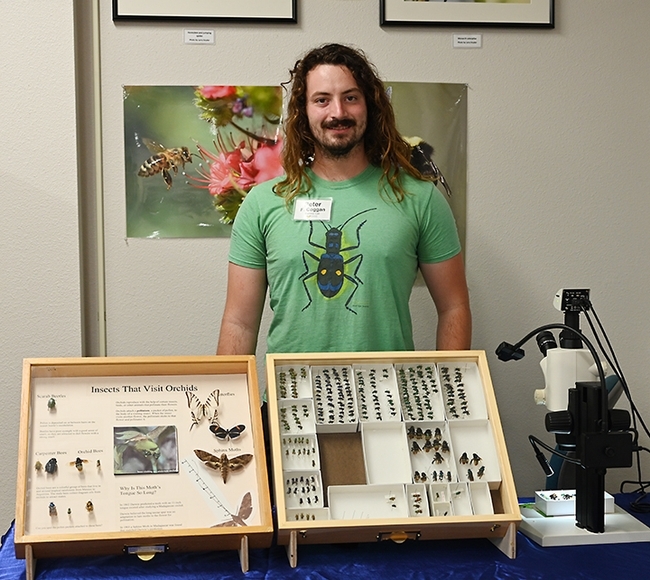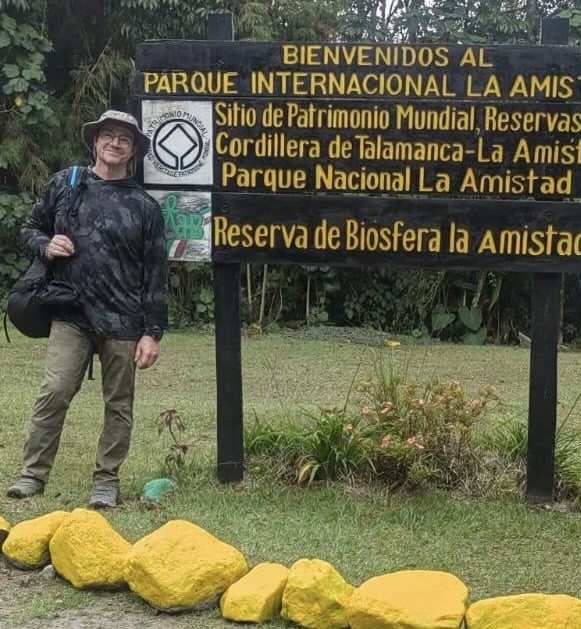
So much to see and do, and so many moth experts will be on hand to answer your questions.
It's all in keeping with National Moth Week.
The event, free and family friendly, will take place inside and outside the Bohart Museum, located in Room 1124 of the Academic Surge Building, 455 Crocker Lane, UC Davis, as well as in the hallway of Academic Surge,and outside.
Moth'ers Peter Coggan, a doctoral student in the laboratory of Santiago Ramirez, UC Davis Department of Evolution and Ecology, and his father, Peter Coggan of northern Minnesota, and active in the Minnesota chapter of National Dark Skies, will staff a moth sensory booth.
Together they can address such topics as moth sensory biology, husbandry, trapping, and light pollution.
The younger Coggan, a member of the UC Davis Population Biology Graduate Group, was born and raised in Boulder, Colo., where he developed a love for biodiversity in the surrounding mountains. He is broadly interested in how sensory processing shapes memory formation and other cognitive traits. He is currently investigating "how hover flies decide which flowers to visit based on innate color preference and learned odors." He began conducting research in high school and has participated in projects from cancer diagnostics to waste water management. He received a bachelor of science in biology from Case Western Reserve University, Cleveland. As an undergraduate, he worked with Dr. Mark Willis and studied how moths perceive smell while moving through a complex environment. Coggan anticipates a career in academia and "to continue to raise awareness about invertebrates."

Jeff Smith, curator of the Lepidoptera collection, and Bohart associate Greg Kareofelas will show moth specimens and answer questions. The Bohart Museum's global collection of 8 million insects includes some 825,454 specimens of moths and butterflies, incluing 618,750 moths, ranging in size from the huge Atlas moths (10-inch wingspan) to the extremely tiny (4 mm wingspan) leafminer moths.”
Silks of the world also will be displayed, announced Tabatha Yang, education and outreach coordinator.
In the hallway, visitors can view wing scales and antennae through microscopes at a table staffed by Iris Quayle, doctoral student in the lab of Professor Jason Bond, director of the Bohart Museum, the Evert and Marion Schlinger Endowed Chair, UC Davis Department of Entomology and Nematology, and associate dean, Agricultural Sciences, UC Davis College of Agricultural and Environmental Sciences.
The petting zoo, featuring Madagascar hissing cockroaches and stick insects, also is scheduled to include Polyphemus caterpillars, "if they haven't all pupated," Yang said. The caterpillars will turn into silk moths. Staffing the petting zoo are UC Davis undergraduate student Kaitai Liu and doctoral candidate Emma Jochim of the Bond lab.
The family craft activity will involve making caterpillar stress balls in a cocoon bag, donned with leaves on the outside.
A free public snack of hot chocolate and cookies will be offered, Yang said.
Outside on the grounds, Bohart research associate John "Moth Man" De Benedictus and his colleagues will set up a blacklighting display (a white sheet and a UV light to attract moths and other night-flying insects). De Benedictis has amassed a moth collection of some 600 species from the Stebbins Cold Canyon Reserve and 300 species from his backyard in Davis. He received a grant from the former Institute of Ecology to study moths at the Stebbins Cold Canyon Reserve where he collected from 1989 until the last major fire in 2020.
“I began a similar inventory of the species in my backyard after I purchased my home in 1998," De Benedictis said. "It continues to this day, and a synoptic collection of the 300 or so species that I've collected in my yard is housed alongside the Cold Canyon collection in the Bohart Museum.” Graduate student Grace Horne of the lab of urban landscape entomologist Emily Meineke, Department of Entomology and Nematology, is analyzing the data from these studies as part of her doctoral research.
DeBenedictus retired in 2001 from the UC Davis Department of Entomology and Nematology, where he worked as a staff research assistant from 1995 to 2001 in the laboratory of medical entomologist Tom Scott. De Benedictis, who holds a master's degree in entomology from UC Berkeley, studied with noted professor Jerry Powell (1933-2023), emeritus director of the Essig Museum of Entomology.
Worldwide, scientists have described about 18,000 species of butterflies and 180,000 species of moths, "and hundreds of newly named species are added every year," Smith said. "It's also believed that we may know of no more than 10-15 percent of the species actually out there, with the small 'micro-Lepidoptera' likely with over 90 percent of the species in the world still unknown. This emphasizes the importance of preserving natural environments so things don't go extinct before we can ever recognize their importance to the Earth and their relationships in their habitats."
Attached Images:

